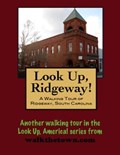There is no better way to see America than on foot. And there is no better way to appreciate what you are looking at than with a walking tour. This walking tour of Ridgeway, South Carolina is ready to explore when you are. Each walking tour describes historical, architectural landmarks, cultural sites and ecclesiastic touchstones and provides step-by-step directions.
Every tour also includes a quick primer on identifying architectural styles seen on American streets.
The actual geological "ridge" indeed played a critical role in the town of Ridgeway, both in its founding and its development. The settlement of New Town came about just before the dawn of the 19th century when planters from Columbia and Charleston found the elevation provided a respite from the heat and humidity of southern summers. One of these planters, Edward Gendron Palmer, of Saint James Parish in Santee, moved into the area in 1824. In 1845 Palmer joined a consortium of cotton growers to promote a railroad from Charlotte to Charleston.
When it came time to select a route for the new Charlotte and South Carolina Railway the road followed the ridge of high land running directly through New Town and Palmer's plantation. That "ridge way" gave the town a new name when the railroad was completed in 1850 and also spurred the growth of the town. The first telegraph in the area was completed about 1855 adding to Ridgeway's importance during the War Between the States.
After a period of economic depression following the Civil War, Ridgeway began to develop as a commercial center serving area farmers. The town had a commercial block with ten stores by 1880. Between 1880 and 1910, when a rise is cotton production was accompanied by sustained high prices, Ridgeway entered a period of prosperity. Stores and residences were built in the popular Queen Anne and Neoclassical styles of the day. Brick was the building material of choice in the commercial district, a reflection of the prosperity of the era.
After 1910 a decrease in cotton production and prices brought the good times to a halt. In the 1930s the population of Ridgeway was 404; by 1970 it had grown only to 437. Cotton was replaced by beef cattle and plantation pines. Today the Ridgeway Historic District is significant as an example of a virtually intact turn-of-the-century town whose development was inextricably tied to agricultural prosperity. A majority of the buildings in the district were built between 1890 and 1915, the heyday of cotton production in the area.
Our walking tour will begin in a parking area near the center of town, adjacent to which is one of the more curious buildings in South Carolina...

